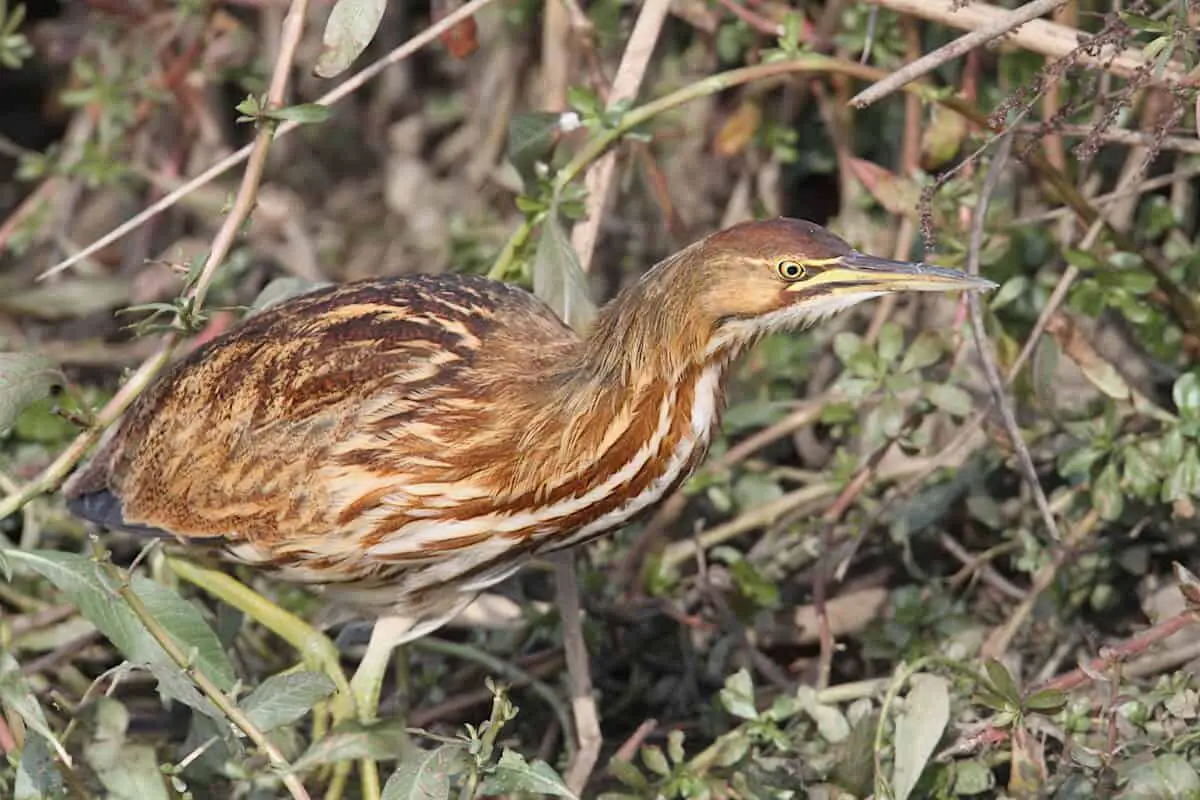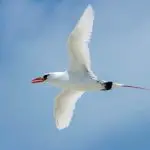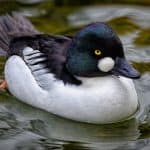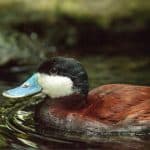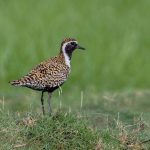Common Name: American Bittern
Scientific Name: (Botaurus lentiginosus)| Size | Diet | Range in Hawaii | Status in Hawaii |
|---|---|---|---|
| 24 in. - 33 in. | insects, small fish, crayfish, crabs, snakes and amphibians | Unkown | Least Concern |
The American Bittern is a wading bird species that is native to North America. While the species is not native to Hawaii, it has been known to make occasional appearances on the islands as a non-breeding visitor and vagrant. With its unique appearance and elusive behavior, the American Bittern is a fascinating bird species that has captured the attention of birdwatchers and avian enthusiasts around the world.
In this article, we will explore the world of the American Bittern, its unique characteristics, and its occasional presence in Hawaii.
American Bittern
Appearance
The American Bittern emerges as a master of camouflage with its distinctive appearance. Standing at around 24 to 33 inches in height, this heron showcases a slender yet sturdy build, perfectly adapted to its wetland habitats.
Its plumage is a blend of rich browns and creams, with long brown streaks running down their neck and chest. This creates a remarkable mimicry of reeds, cattails, and other marsh grasses, allowing it to seamlessly merge into its surroundings. Topping off its enigmatic aura is a long, pointed, yellowish bill.

Diet
The American Bittern boasts a versatile diet, feasting on a spectrum of aquatic creatures such as insects, small fish, crayfish, crabs, snakes and amphibians, showcasing its prowess as a skilled predator in wetland ecosystems. Their insect diet includes both aquatic insects like water striders, beetles and water bugs, as well as flying insects like dragonflies and terrestrial insects like grasshoppers.
Nesting

During the nesting season, the American Bittern’s behavior transforms from its normally secretive demeanor to an extraordinary courtship ritual. Males emit an otherworldly symphony of low-pitched, resonating “pump-er-lunk” calls, which reverberate across the tranquil marshes like a cryptic love song. These vocalizations serve a dual purpose: attracting potential mates and establishing territorial boundaries.
Once a pair forms a connection, the American Bittern constructs its nest, often in the heart of dense vegetation. The nest itself is a marvel of architectural ingenuity, composed of woven reeds and plants, forming a platform above the waterline. This strategic elevation ensures that the nest remains safe from rising water levels and potential predators prowling the marshes.
As the female lays her eggs, the bittern’s cryptic coloring continues to serve its purpose. Blending seamlessly with the surrounding plants, the bird appears to vanish into thin air, safeguarding its clutch from prying eyes. This incredible concealment is a testament to nature’s ability to craft astonishing adaptations for survival.
Behavior
Perhaps its most renowned behavior is the mesmerizing “bitterning” call. Like a ghostly whisper, this eerie sound carries across the marshes during the early hours and twilight. It’s as if the bittern has unlocked the secrets of communicating with unseen spirits, creating an ambiance that stirs curiosity and fascination.
However, the American Bittern’s most remarkable skill lies in its ability to melt into its surroundings. When threatened, it adopts a posture that defies detection, elongating its neck and tilting its body upward, resembling a swaying reed. The intricate lines of its plumage match the reeds and grasses, and suddenly, the bittern becomes practically invisible to both predator and prey.
When it’s time to hunt, the bittern unveils yet another facet of its behavior. With a deliberate, slow-motion stride, it stalks its prey in the shallow waters, its dagger-like bill poised for action.
When the moment is right, it strikes with lightning speed, snatching fish, frogs, insects, and other aquatic creatures. This calculated patience in pursuit of sustenance showcases the bittern’s ability to make every move count.
Habitat
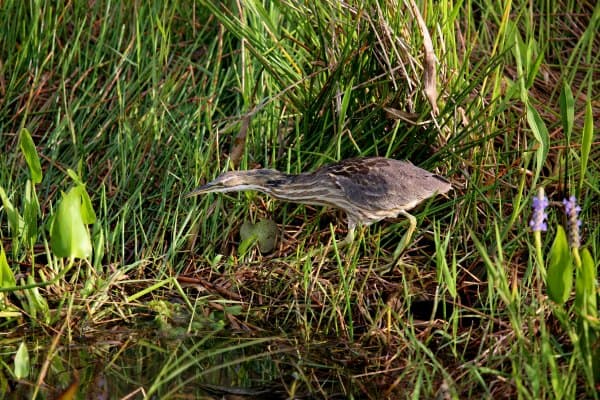
The American Bittern finds its home amidst North American wetlands, where cattails and reeds create a secretive haven. Marshes, swamps, and wet meadows serve as its stage, with the bird’s cryptic plumage blending seamlessly into the tall vegetation.
Range
While its breeding grounds extend across Canada and the northern United States, they move south to winter in the southern U.S., Mexico and Cuba. While not part of their normal winter range, some birds travel all the way to Hawaii during the non-breeding months.
Conservation Status
The American Bittern (Botaurus lentiginosus) is classified as a species of “Least Concern” on the IUCN Red List of Threatened Species. This means that, as of that time, it was not considered to be facing a high risk of extinction in the wild.
Interesting Facts
1. Wetland indicator species
The presence and health of American Bitterns in wetland habitats can serve as indicators of the overall health of those ecosystems. Their presence can signify the vitality of the wetland’s food chain and biodiversity.
2. Ancient relatives
The American Bittern belongs to a family of birds called Ardeidae, which also includes herons and egrets. Bitterns have a lineage dating back millions of years, making them part of an ancient group of water-loving birds.
3. Artistic Inspiration
The American Bittern’s presence and unique behaviors have inspired artists, poets, and writers. Its elusive nature and mastery of camouflage make it a subject of fascination and creative exploration.
4. Cultural significance
In some indigenous cultures, the American Bittern holds symbolic meaning. For example, some First Nations peoples see the bittern as a symbol of determination and persistence due to its seemingly invisible presence and ability to thrive in challenging environments.
5. Distinctive Wing Patches
In flight, American Bitterns reveal striking black wing patches that are normally concealed. These patches are thought to serve as a form of communication, especially during interactions with other bitterns.
Frequently Asked Questions
1. How long do American Bitterns live?
In the wild, American Bitterns have an average lifespan of around 5 to 6 years. However, many factors, including habitat conditions and predation risks, can influence their lifespan.
2. Do American Bitterns interact with other bird species in their habitats?
American Bitterns share their wetland habitats with various other bird species. While they may interact indirectly through competition for resources, bitterns generally prefer to keep a low profile and avoid confrontations.
3. Can American Bitterns swim?
While American Bitterns are not known for their swimming abilities like ducks or other waterfowl, they are capable of swimming if necessary. They often wade in shallow water, but their bodies are not as well adapted to sustained swimming.
4. How can I contribute to the conservation of American Bitterns?
You can support American Bittern conservation by getting involved in wetland restoration projects, supporting organizations focused on wetland protection, and advocating for policies that prioritize the preservation of these important ecosystems.
